2. Sun Yat-sen University, Guangzhou 510275, China;
3. Chiba University, Chiba 271-8510, Japan
2. 中山大学 广州 510275;
3. 日本千叶大学 千叶 271-8510 日本
In the North China Plain (NCP), which comprises both arid and semiarid zones, reclaimed water has been used to solve the problem of reclaimed urban water treatment and the shortage of farmland irrigation water. Properly treated urban living and industrial wastewater comprises several nutrients such as nitrogen, phosphorus, potassium, zinc, and magnesium for crop growth and can be used as a water source for farmland irrigation. If scientific and reasonable management is implemented, reclaimed water irrigation can not only save limited water resources but also exert the selfpurification ability of soil to reduce the pressure of reclaimed urban water discharge on the environment.
Nitrate pollution in groundwater is a common problem worldwide, especially in the recent decades, because of the impact of urban sewage leakage and excessive fertilizer application in concentrated agricultural activities. As a result, the concentration of nitrate in groundwater has been increasing each year (Wang et al., 2018a). Nitrate contamination of groundwater in the NCP has attracted much attention (Wang et al., 2016; Tang et al., 2006). Simultaneously, reclaimed urban water comprising high concentrations of nitrates poses a serious environmental risk, and the problem of declining groundwater quality in areas with long-term reclaimed water irrigation is widespread (Chen et al., 2006). The unsaturated zone is a key area to control the infiltration of surface water and solutes into the aquifer. A proper understanding of the migration pattern of nitrate nitrogen (NO3--N) in the unsaturated zone, surface water, and groundwater can provide theoretical support for the prevention and control of nitrate infiltration from the surface to the underground.
River systems in the NCP are important not only for providing recharge water for groundwater, but also for transporting nutrients. Owing to severe water shortages in the NCP, much of the wastewater is used for irrigation which has caused groundwater pollution (Tang et al., 2004). Several studies have shown that the elevated NO3--N concentrations in groundwater caused by the agriculture activities is the common threaten on groundwater quality. In particular, large amounts of nitrogenous fertilizers input and low using efficiency may lead to nitrate leaching (McArthur et al., 2012; Tang et al., 2004). We conducted an investigation in a typical reclaimed water irrigation area in the NCP, aiming at estimating distribution characteristics and sources of nitrate in the unsaturated zone and groundwater of farmlands.
1 Overview of the study areaIn this study, Xiao River — a sewage river — in Shijiazhuang was selected as the research object (Fig. 1). The Xiao River is a tributary of the upper reaches of Fuyang River in the Ziya River system of the Hai River basin. It originates from the stream of Wufeng Mountain in Luquan City and flows through Luancheng County, Zhao County, and Ningjin County of Shijiazhuang City in Hebei Province, eventually flowing into the Fuyang River. The Xiao River is a typical example of rivers that have been seriously polluted by reclaimed urban water in the NCP. Since the completion of Huangbizhuang Reservoir in the upper reaches in the 1960s, the volume of this river's water has gradually decreased. Industrial and domestic reclaimed waters from Shijiazhuang City and the surrounding area have become the main water source of the Xiao River, causing serious pollution. The pollutants in the water body of the Xiao River exceed the standard limit, and the river is now a sewage river of Shijiazhuang. In the lower reaches of the city, reclaimed water has been used on a large-scale for farmland irrigation since the 1970s, and this area is one of the most typical areas irrigated with reclaimed water in North China.
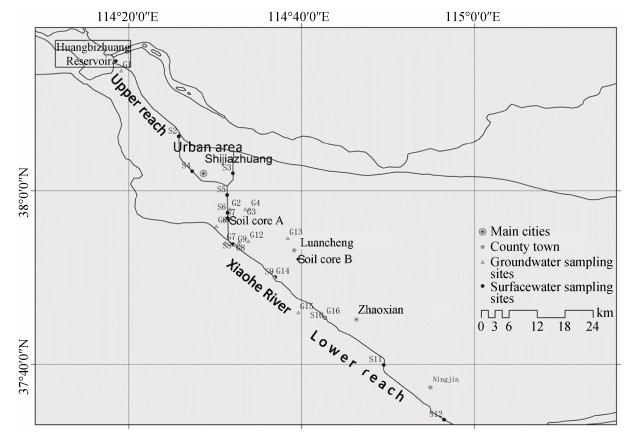
|
Fig. 1 Study area and sampling locations |
The quaternary sediments in the study area are controlled by the bedrock structure, and they gradually thicken from northwest to southeast. They mainly comprise two sub-regions of Hutuo River alluvial fans and Huaisha River alluvial fans. The groundwater in the study area mainly exists in the pores of the loose quaternary rock formation. According to the lithology, hydrodynamic conditions, and aquifer distribution of the quaternary sedimentary strata, it can be divided into four water-bearing units: the Holocene, Upper Pleistocene, Middle Pleistocene, and Lower Pleistocene series (Yang et al., 2006). The bottom interface of the first upper aquifer formation generally has a burial depth of < 50 m, and the water-bearing body is directly exposed or covered by a thin layer of sandy clay, showing strong infiltration and recharge conditions. The bottom boundary of the second aquifer formation generally has a burial depth of 120-210 m. The second and the first aquifer formations hydraulically connected due to a no stable aquifer between them, and the connection is artificially strengthened by the mixed mining of the first and second aquifer formations. The first and second aquifer formations are the key research objects of this study and belong to the shallow aquifer, which is a submerged or micro-confined aquifer. The third and fourth aquifer formations are deep formations with a bottom burial depth of 250-310 m, and they belong to a confined aquifer. The shallow aquifer of groundwater in the study area is mainly recharged by atmospheric precipitation, river infiltration, and farmland irrigation (Li et al., 2008). The main discharge modes are artificial mining and phreatic evaporation. Because of the long-term anthropogenic overexploitation, the regional groundwater level has significantly decreased, and the buried depth is generally approximately 25-35 m.
The study area belongs to the alluvial fan plain on the piedmont slopes of the east side of Taihang Mountain. The annual average temperature in the area is 13 ℃, and the climate is temperate, semiarid, and semihumid continental monsoon. The average annual precipitation is 573 mm, with a maximum of 1 168 mm and a minimum of 335 mm (based on the data from 1951 to 2003) (Zhang et al., 2009). The average possible evaporation of multiple years is 1 928 mm (Dun et al., 2014).
The main crops in the study area are winter wheat and summer crops, forming a rotation system of double cropping in one year. The irrigation volume for the two season crops is approximately 350 mm (Li et al., 2006).
2 Research methodsTo understand the nitrate pollution status in the unsaturated zone, surface water, and groundwater, we conducted field surveys in spring and autumn (March and October, 2016). Samples were collected from 12 surface water sites (S1 to S12), 17 groundwater sites (G1 to G17), and 2 undisturbed soil column sites (Soil A and Soil B, Fig. 1). The groundwater level, water temperature, conductivity, and pH were measured in the fields. The main ions (Na+, K+, Ca2+, Mg2+, Cl−, NO3-, and SO42−) were analyzed using ion chromatography (IC, LC-10AD, Shimadzu, Japan).
To compare the current situation of nitrate migration in the unsaturated zone of farmlands under different irrigation conditions, we used the sampling vehicle for an undisturbed soil column (Model 54DT, Geoprobe, US) to collect the undisturbed soil columns in the unsaturated zones of the reclaimed water irrigation zone (A) and the groundwater irrigation zone (B) (Fig. 1), with sampling depths of 7.4 m and 7.9 m, respectively. In the range of 1 km from the Xiao River, soil column A was collected in the area with long-term irrigation of reclaimed water from the river channel. Soil column B was collected at the Luancheng Agro-Ecosystem Experimental Station of Chinese Academy of Sciences, where is a typical high-yield area with the same cropping system and climate. However, soil column B is irrigated with groundwater instead of reclaimed water. The recovered soil core was cut every 5 cm in the laboratory for analyses of major ions. The cut soil samples were then oven dried at 105 ℃ for 48 h to determine the soil moisture content. Subsequently, 50 mL of deionized water was added to 10 g of dried soil. The mixture was placed in a reciprocal shaker at 120 rpm for 6 h, centrifuged at 3 000 rpm for 20 min, and the supernatant was filtered through a 0.2-μm syringe filter. The chemical parameters analyzed included pH, EC, and major ions (Cl− and NO3-) in the water that leached from the soil samples. The concentrations of major ions were measured using ion chromatography (LC-10AD, Shimadzu, Japan).
The age of the groundwater in this study was determined by analyses of freon (CFC-12) according to the methods described by Oster et al. (1996). The water samples were conserved in the field in 50-mL brown glass bottles sealed with aluminum-lined caps. CFCs in the water samples were measured using closed-system purge and trap gas chromatography equipped with an electron capture detector (GC-ECD, Shimadzu, Japan).
3 Results and discussion 3.1 Effects of reclaimed water irrigation on surface water nitrogen concentrationIn spring (March), the concentration of NO3- in the surface water gradually increased from the Huangbizhuang Reservoir in the upper reaches (7.7 mg·L−1, S1) to the urban area (S2-S4) (30.8 mg·L−1, S4, Fig. 2). In the lower reach of the city, NO3- was undetected at all sites, except for the reclaimed water treatment plant (S6), where a high concentration of NO3- was detected instead. In autumn (October), the concentration of NO3- from the upper reach to the middle reach increased from 6.7 mg·L−1 (S1) to 46.0 mg·L−1 (S6). NO3- also exhibited pronounced seasonal differences in the surface water, and the concentration of NO3- in the spring was significantly higher than that in the fall. The concentration of NH4+ reached 145.01 mg·L−1 in the spring because a large amount of reclaimed urban water from the lower reach of the city was discharged into the Xiao River, and NH4+ in the water from the lower reach of the city became the main form of nitrogen (Fig. 2).
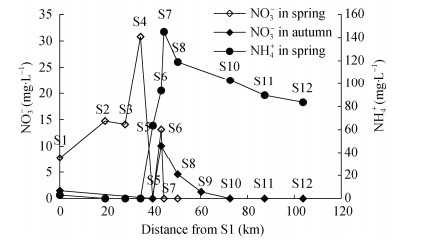
|
Fig. 2 NO3− and NH4+ concentrations variations in surface water along the Xiao River in autumn and spring in 2016 |
The NO3− concentration in the groundwater ranged from 4.0 mg·L−1 to 156.6 mg·L−1, with an average of 53.9 mg·L−1 (Fig. 3), which is higher than the drinking water standard (50 mg·L−1) of World Health Organization (WHO). According to this standard, the results of the groundwater with a well depth of < 70 m and within 2 km of the Xiao River generally exceeded the limits for drinking water stated by WHO, indicating that reclaimed water irrigation affects the concentration of NO3− in the groundwater in both horizontal and vertical directions. By comparison, Tang et al. (2006) reported in 2000 that the NO3− concentration in the groundwater in the Xiaohe basin with a well depth of < 40 m exceeded 50 mg·L−1. After 12 years, the migrating frontal line of nitrate infiltration decreased by nearly 30 m, suggesting that the calculated vertical migration rate of nitrate ions (1-2 m per year) reported by Tang et al. was reliable.

|
Fig. 3 Variations in the concentration of NO3- with well depth and distance from the river |
Cl- is a relatively stable ion in an aqueous environment, and not easily adsorbed and degraded. Therefore, the concentration of Cl- is often used as an indicator to explain the movement of water in unsaturated zones, surface water, and groundwater (Panno et al., 2006). Cl- usually has natural and anthropogenic sources. In this study area, almost no natural Cl- enters the water environment. Therefore, the Cl- concentration can be used as an indicator of anthropogenic influence to explain the source of nitrate. The Cl- concentration exhibited a good correlation with nitrogen in the surface water (R2 = 0.896) and groundwater (R2 = 0.908), indicating that the source of nitrogen in the surface water and groundwater is mainly anthropogenic discharges (Fig. 4).

|
Fig. 4 Relationship between NO3-+NH4+ and Cl− in the surface water and groundwater |
To better illustrate the migration process of NO3−-N in the reclaimed water irrigation area, this study compared the effects of irrigation on the migration of NO3−-N in farmland soil. The contents of NO3− in the soil samples of the reclaimed water irrigation area and the groundwater irrigation area were determined. A significant difference was observed in the distribution of NO3− between the groundwater and reclaimed water irrigation areas. The average contents of NO3− in the reclaimed water and groundwater irrigation areas were 137.0 mg·kg−1 and 107.7 mg·kg−1, respectively. In the reclaimed water irrigation area, the maximum content of NO3− was 523.2 mg·kg−1 at a soil depth of 1.20 m, and multiple peak values appeared at 1.60−1.80 m and 2.40-3.40 m. In the groundwater irrigation area, the soil NO3− was mainly distributed in the soil layer with a depth of < 1.20 m, and the maximum content of NO3− was 725.9 mg·kg−1 at a depth of 0.85 m. From the depth of 0.85 m to 1.25 m, the content of NO3− rapidly decreased to 9.5 mg·kg−1, and until the deepest sampling depth (6.8 m), it was maintained at a low level of 0-44.2 mg·kg−1 (Fig. 5). Under the protection of the thick unsaturated zone formed by severe overexploitation of groundwater in the NCP and denitrification, the nonpoint source pollution of farmland exhibits a limited effect on groundwater pollution. There is a relatively high risk of groundwater NO3−-N pollution around the reclaimed water rivers.
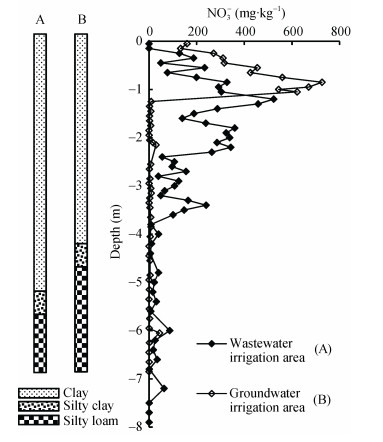
|
Fig. 5 Soil classification and concentration profiles of water-soluble NO3- (A) in wastewater irrigation area and soil core (B) in groundwater irrigation area |
According to the correlation analysis between NO3− and Cl- in the soil samples from the reclaimed water and groundwater irrigation areas, a strong correlation was noted between Cl- and NO3− in the reclaimed water irrigation area (R2 = 0.766). The content of NO3− increased with an increasing content of Cl- (Fig. 6). However, in the groundwater irrigation area, no pronounced linear relationship was noted between the increase in the contents of Cl- and NO3−, and the content of Cl- did not showed substantial changes. This phenomenon suggest that the NO3− pollution in the reclaimed water irrigation area mainly affected by reclaimed urban water, whereas the source of NO3− in the groundwater irrigation area is not urban reclaimed water and may be because of the use of agricultural nitrogen fertilizers.
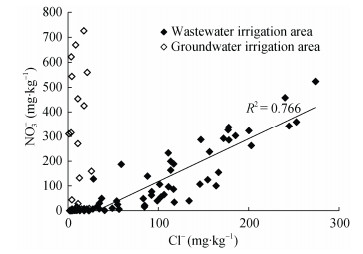
|
Fig. 6 Relationship between the contents of NO3− and Cl- in soil core samples |
Anthropogenic causes are apparently involved in the elevated concentrations of NO3− in shallow groundwater. Therefore, it is necessary to determine the effects of anthropogenic activities on NO3−-N pollution in shallow groundwater. The use of groundwater age can reproduce the process of the increase in the concentration of NO3−, which has been affected by anthropogenic activities, on a time scale (Gourcy et al., 2009). Groundwater age allows us to determine whether high concentrations of NO3− in groundwater are related to anthropogenic activities (Wang et al., 2018b).
Because of the slow NO3− migration rate during the leaching process in the unsaturated zone, NO3−-N pollution in groundwater may not be detected for decades. Therefore, by combining the groundwater aging technique with water chemistry and distinguishing the temporal variation characteristics of pollution sources, the historical source of NO3−-N can be determined (Cao et al., 2013). The present study used a technique in which freon (CFC-12) was used to determine the age of selected shallow groundwater.
The results showed that the concentration of NO3− in the groundwater recharged after 1975 was significantly higher than that recharged before 1975. This trend is suggestive of anthropogenic activities, similar to the reclaimed water irrigation in the Shijiazhuang area since the 1970s. There was a clear positive exponential relationship between the groundwater age and the concentration of NO3− in the groundwater, indicating that groundwater pollution was closely related to the leaching of NO3− produced from the historical source to the lower layer through the unsaturated zone (Fig. 7).
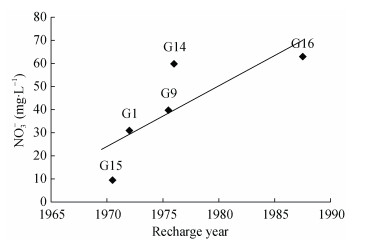
|
Fig. 7 Relationship between NO3- concentrations and apparent ages of freon (CFC-12) |
In the Xiao River basin, which is seriously affected by reclaimed urban water, relatively high concentrations of NO3− were commonly observed in the water environment. The correlation between the concentrations of NO3− nitrogen and Cl- showed that reclaimed urban water was the main source of NO3− in the unsaturated zone, surface water, and groundwater. The NO3−-N in the groundwater around the reclaimed urban water river continued to diffuse at an annual migration rate of 1-2 m and formed a NO3−-N diffusion zone with a depth of 70 m and at a distance of 2 km from the river channel. By analyzing the correlation between NO3− and Cl- in the unsaturated zone, different nitrogen sources could be clearly distinguished between the reclaimed water and groundwater irrigation zones. Under the unique hydrogeological background of the NCP, the nonpoint source pollution of the farmland has a limited effect on groundwater pollution, while the risk of groundwater NO3−-N pollution is relatively high around the reclaimed water river. An accurate understanding of the NO3−-N migration pattern in the unsaturated zone, surface water, and groundwater can provide better theoretical support for the prevention and control of NO3− infiltration from the surface to the underground.
CAO Y, TANG C, SONG X, et al. 2013. Residence time as a key for comprehensive assessment of the relationship between changing land use and nitrates in regional groundwater systems[J]. Environmental Science:Processes & Impacts, 15(4): 876-885. |
CHEN J, WANG Y, ZHANG H, et al. 2006. Overview on the studies of nitrate pollution in groundwater[J]. Progress in Geography, 25(1): 34-44. |
DUN Y, TANG C, SHEN Y. 2014. Identifying interactions between river water and groundwater in the North China Plain using multiple tracers[J]. Environmental Earth Sciences, 72(1): 99-110. DOI:10.1007/s12665-013-2989-4 |
GOURCY L, BARAN N, VITTECOQ B. 2009. Improving the knowledge of pesticide and nitrate transfer processes using age-dating tools (CFC, SF6, 3H) in a volcanic island (Martinique, French West Indies)[J]. Journal of Contaminant Hydrology, 108(3/4): 107-117. |
LI F, PAN G, TANG C, et al. 2008. Recharge source and hydrogeochemical evolution of shallow groundwater in a complex alluvial fan system, southwest of North China Plain[J]. Environmental Geology, 55(5): 1109-1122. DOI:10.1007/s00254-007-1059-1 |
LI X, HU C, LEI Y, et al. 2006. Calculation for the accumulation of nitrate nitrogen in a Luancheng soil by geoprobe[J]. Chinese Journal of Soil Science, 37(5): 906-908. |
McARTHUR J, SIKDAR P, HOQUE M, et al. 2012. Waste-water impacts on groundwater:Cl/Br ratios and implications for arsenic pollution of groundwater in the Bengal Basin and Red River Basin, Vietnam[J]. Science of the Total Environment, 437: 390-402. DOI:10.1016/j.scitotenv.2012.07.068 |
OSTER H, SONNTAG C, MÜNNICH K O. 1996. Groundwater age dating with chlorofluorocarbons[J]. Water Resources Research, 32(10): 2989-3001. DOI:10.1029/96WR01775 |
PANNO S, HACKLEY K, HWANG H, et al. 2006. Characterization and identification of Na-Cl sources in ground water[J]. Ground Water, 44(2): 176-187. DOI:10.1111/j.1745-6584.2005.00127.x |
TANG C, CHEN J, SHINDO S, et al. 2004. Assessment of groundwater contamination by nitrates associated with wastewater irrigation:a case study in Shijiazhuang region, China[J]. Hydrological Processes, 18: 2303-2312. DOI:10.1002/hyp.5531 |
TANG C, CHEN J, SONG X, et al. 2006. Effects of wastewater irrigation on groundwater quantity and quality in the suburbs of Shijiazhuang City, China[J]. Resources Science, 28(1): 102-108. |
WANG S, TANG C, SONG X, et al. 2016. Factors contributing to nitrate contamination in a groundwater recharge area of the North China Plain[J]. Hydrological Processes, 30(13): 2271-2285. DOI:10.1002/hyp.10778 |
WANG S, ZHENG W, KONG X. 2018a. Spatial distribution characteristics of nitrate in shallow groundwater of the agricultural area of the North China Plain[J]. Chinese Journal of Eco-Agriculture, 26(10): 1476-1482. |
WANG S, YUAN R, TANG C, et al. 2018b. Combination of CFCs and stable isotopes to characterize the mechanism of groundwater-surface water interactions in a headwater basin of the North China Plain[J]. Hydrological Processes, 32(11): 1571-1587. DOI:10.1002/hyp.11494 |
YANG Y, WATANABE M, ZHANG X, et al. 2006. Optimizing irrigation management for wheat to reduce groundwater depletion in the piedmont region of the Taihang Mountains in the North China Plain[J]. Agricultural Water Management, 82(1/2): 25-44. |
ZHANG Z. 2009. Investigation and evaluation of sustainable utilization of groundwater in the North China Plain[M]. Beijing: Geological Publishing House.
|
 2019, Vol. 27
2019, Vol. 27



